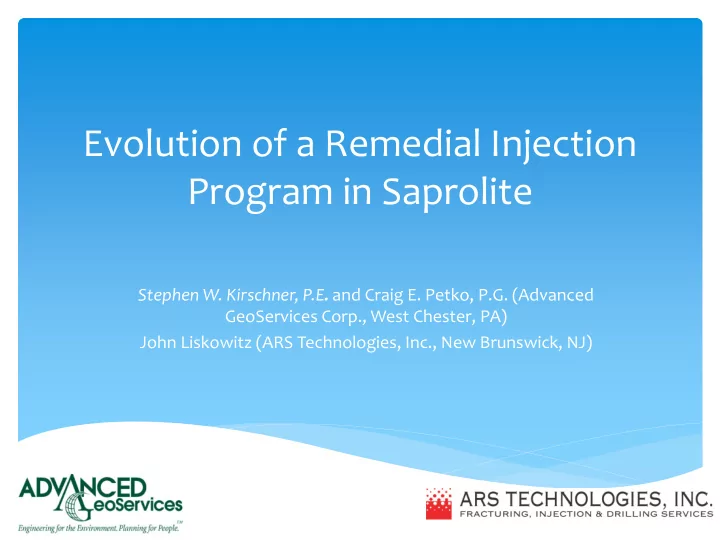

Evolution of a Remedial Injection Program in Saprolite Stephen W. Kirschner, P.E . and Craig E. Petko, P.G. (Advanced GeoServices Corp., West Chester, PA) John Liskowitz (ARS Technologies, Inc., New Brunswick, NJ)
Background ∗ North Carolina Registered Environmental Consultant Program ∗ Manufacturing Facility since 1955 on 6.8 acres ∗ Former owner responsible for remediation ∗ New businesses/owners continue at property ∗ Six Groundwater AOC’s (area of concern) ∗ TCE, 1,2-DCE and Vinyl Chloride primary COCs
Site Conceptual Model Topographical High Residual clayey silts 6 m Decomposed bedrock (Saprolite) Steeply fractured Paleozoic Quartz / Feldspar Granite & Hornblende Diorite (TCE migration to 250+ ft)
Encountered Geology (Drilling methodology) ∗ Residual clayey silts ∗ Direct Push Geoprobe, Solid Flight Augers ∗ Decomposed bedrock (Saprolite) ∗ Solid Flight Augers, Sonic Drilling
Insitu Remediation Challenges ∗ Restricted access in side building ∗ Minimize business disruption to current tenants ∗ Saprolite highly variable ∗ Metamorphic bedrock matrix ∗ Effective reagent distribution in heterogeneous geology ∗ Off-site migration ∗ No risk-based protocols in REC Program
Low Clearance
Indoor Air Quality Protection
Injection Materials ∗ Fracturing ∗ Phase I ∗ Hydraulic Fracture Emplacement ∗ Phase II ∗ Pneumatic Fracture Emplacement ∗ Treatment Injectant Material ∗ Vegetable Oil Emulsion (VOE) ∗ Chase water (NaOH added during Phase II)
Phase I Fracture Emplacement Extension of Initial Bedrock Injection Program d Return Water acker strength limitations Prolonged cutting
Summary of First Method ∗ Top Down Approach ∗ Direct-Push 2-inch steel pipe ∗ Retract 6 inches ∗ Hydraulically cut notch in formation ∗ Propagate fracture with guar gel and sand ∗ Inject SRS, Sodium Carbonate & Chase Water ∗ Drive to next depth and repeat
Phase I Fracture Emplacement Summary ∗ 4 wells & 22 injection 500 1000 450 900 intervals 400 800 ∗ Refusal 18 ft to 57 ft 350 700 300 600 (avg = 34 ft) 250 Injection 500 ∗ Est. ROI = 20 to 30 ft Event 200 400 150 300 ∗ Vol. treated = 6,000 cy 100 200 50 100 ∗ 595 gals of 60% VOE 0 0 Time concentrate
Phase II – Full-Scale Hydraulic Fracture Pneumatic Fracture Emplacement Emplacement
Pneumatic Fracturing Emplacment Injection Process (By Changing Viscosity of Treatment Media more effective distribution in Subsurface results) Conventional Hydraulic Pneumatic Fracture Injection of Liquid Emplacement The same liquid blended with gas as it Shows hydraulic injection of liquid becomes atomized
Additional Improvements Implemented During Phase II Use of Small Rotosonic Rig enabled injections to Formation improvement occur at any target depth without encountering Refusal
Phase II Methods ∗ Roto-sonic and Hollow Stem Augering used to advance holes ∗ Fracture entire overburden column first using nitrogen to establish fracture network and increase formation permeability (before injecting treatment material). ∗ Once hole fractured, advance tooling to depth and begin injections bottom up manner ∗ Straddle Packers used to isolate 3 foot injection interval ∗ Liquid atomized injection using nitrogen on site improved treatment material distribution
Injection Variability (Injection ROI was increased as depth increased and more competent Material Encountered) 30 Foot Depth 50 Foot Depth
Baseline Conditions - Est. 123,500 ft 2 plume size & Post Phase I Injection Conditions - Est. 54,000 ft 2 plume size
Post Phase I Injection Conditions - Est. 54,000 ft 2 plume size & Post Phase II Injection Conditions- Est. 32,000 ft 2 plume size
Phase I & II Comparison ∗ Phase I (Hydraulic Fracturing Emplacement) ∗ Radius of Injection = 20 to 25 ft ∗ Volume treated = 6,000 cy ∗ Treatment Depth = 18 ft to 57 ft bgs (average = 34 ft) ∗ Phase II (Pneumatic Fracture Emplacement) ∗ Radius of Injection = 15 to 45 ft (decreasing w/ depth) ∗ Volume treated = 22,000 cy ∗ Treatment Depth = 45 ft to 77 ft bgs (average = 60 ft)
Total Capital Costs Summary ∗ Includes: Mob/Demob, Drilling, Injection, All Materials, Oversight, & Restoration ∗ Phase I Hydraulic Fracture Emplacement (22 injections – Avg. 34 ft Depth) ∗ $3,000 per injection or $11 per cubic yard ∗ Time to Complete 9 days ∗ Phase II Pneumatic Fracture Emplacement (81 injections – Avg. 60 ft Depth) ∗ $3,800 per injection or $13 per cubic yard ∗ Time to Complete 30 days
Conclusions ∗ Difficult & Varied Saprolite geology required a more advanced drilling method during Phase II to adapt to penetrate less weathered zones ∗ Significant formation changes occurred over short distances that impacted distribution and caused injection hole by hole customization ∗ Goal of creating in-situ bioreactor by distributing treatment material throughout majority of target area achieved ∗ Significant (99%) VOC reductions achieved ∗ Appreciable cost savings resulted due to better reagent distribution
Evolution of a Remedial Injection Program in Saprolite ∗ QUESTIONS ∗ Stephen Kirschner, P.E. – 610-840-9117 ∗ John Liskowitz – 732-296-6620 ext 101
Recommend
More recommend